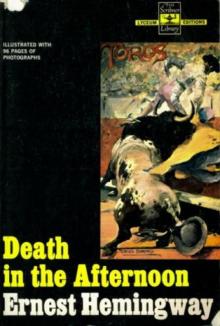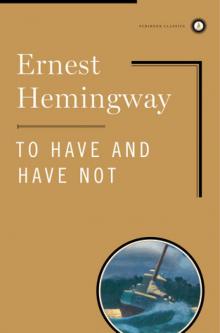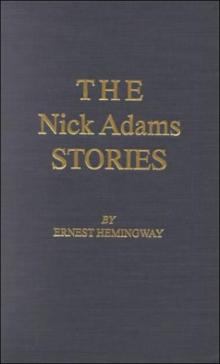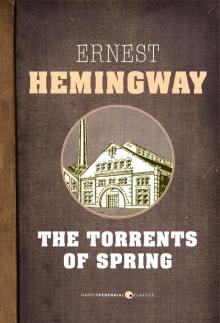- Home
- Ernest Hemingway
Dateline- Toronto Page 8
Dateline- Toronto Read online
Page 8
Put it in the baker with a good slow fire for forty-five minutes and then take it out, and if your pals are Frenchmen they will kiss you. The penalty for knowing how to cook is that the others will make you do all the cooking.
It is all right to talk about roughing it in the woods. But the real woodsman is the man who can be really comfortable in the bush.
Ted’s Skeeters
The Toronto Star Weekly
August 7, 1920
He is one of the few wild animals that are not afraid of man. He scents him afar off and with a zooming cry attacks him and sucks his blood. He has driven men to madness and made whole sections of a continent uninhabitable. No, he is not a vampire bat, he is the mosquito.
This yarn is for the city dweller who can’t get away for a vacation this summer. When he finishes it he will chortle with glee, think sadly of the poor people who have gone up into the bush and stride off to a movie with his heart full of love for Toronto. There are very few mosquitoes in Toronto.
We were up in the bush. Our camp was so far out in the tall and unsevered [bushes] that there wasn’t even an echo. An echo would die of lonesomeness out there.
The first night was perfect. There was a wind from the north and it was cold and we slept like logs. There wasn’t a mosquito around.
But the next night at dusk a warm south wind brought them up from the cedar swamp in clouds. If you have never seen a cloud of mosquitoes you cannot appreciate it. It is just like a cloud of dust. Only it is mosquitoes.
We retired into our tent and dropped the mosquito netting over the front. Pretty soon a mosquito bit me on the nose. I killed him and another took his place. Ted lit a candle and started to hunt down all the mosquitoes in the tent. We cleared the tent of them and lay down to sleep and then came that familiar zoom and another proboscis was inserted into my face.
The mosquitoes were coming through the netting as though it were the bars of a cage. By smearing ourselves with citronella oil we managed to get some sleep. About as much sleep as a man gets with a few thousand buzzing, biting, ungentlemanly insects settling down on his face as soon as it comes out of the blankets and satisfying their hunger by pushing their bills into his countenance.
The next night I came in soaked and tired from a day’s fly fishing and as I emptied my creel I noted a hunted look on Ted’s face.
“I lost the skeeter dope,” he said.
“You what?” said I, paralyzed.
“I was trying to get the cork out and it stuck and I pushed it in and then I set the bottle down and it spilled.”
Then I knew how Napoleon felt on St. Helena and what Caesar’s feelings were when he observed Brutus sticking his jackknife in him, and how the “only one grain of corn, mother” bird felt when he found that there wasn’t any corn.
We were out for two weeks. We were twenty-six miles from the nearest town. Our mosquito netting had meshes that would permit a mosquito to be as active as a Sinn Feiner, and Ted had lost the mosquito dope.
Just then a warm breeze commenced to blow from the south across the cedar swamp up toward the high ground of our camp and a keen observer could have seen what looked like a cloud of dust coming up from the swamp. Then I began to appreciate mosquitoes.
We built two smudges and sat between them. The mosquitoes stuck around and every once in a while made a dash through the smoke.
Then we built four smudges and sat inside of them. The mosquitoes came in through the cracks in the smoke. We began to feel like smoked hams. I suggested as much to Ted.
“We are,” he said.
Then I started to cheer him up.
“Suppose,” said I, “that mosquitoes were as big as crows? What chance would we have then?” He said nothing.
“Suppose they ate fish? There wouldn’t be a fish in the stream.” He didn’t reply.
“We’ve got a lot to be thankful for,” I said.
“Oh, shut up!” he said in a very unmannerly way.
We stuck it for two weeks. But sometimes we were pretty desperate.
Ted suggested that after we had eaten my cookery for a long enough time we would be poisonous to a mosquito.
I retorted that he was probably poisonous to them anyway.
He suggested that I had bought that mosquito netting.
I asked who lost the skeeter dope?
He threw a flapjack at me.
Finally, after a few days it commenced to blow from the north, and we didn’t see another mosquito.
Ted remarked that I was a fine cook.
I said that he certainly cast a wicked fly.
The moral is that we should have had cheesecloth instead of the kind of mosquito netting they are selling this year. And you need two bottles of dope. Better make it three.
The Best Rainbow Trout Fishing
The Toronto Star Weekly
August 28, 1920
Rainbow trout fishing is as different from brook fishing as prizefighting is from boxing. The rainbow is called Salmo iridescens by those mysterious people who name the fish we catch and has recently been introduced into Canadian waters. At present the best rainbow trout fishing in the world is in the rapids of the Canadian Soo.
There the rainbow have been taken as large as fourteen pounds from canoes that are guided through the rapids and halted at the pools by Ojibway and Chippewa boatmen. It is a wild and nerve-frazzling sport and the odds are in favor of the big trout who tear off thirty or forty yards of line at a rush and then will sulk at the base of a big rock and refuse to be stirred into action by the pumping of a stout fly rod aided by a fluent monologue of Ojibwayian profanity. Sometimes it takes two hours to land a really big rainbow under those circumstances.
The Soo affords great fishing. But it is a wild nightmare kind of fishing that is second only in strenuousness to angling for tuna off Catalina Island. Most of the trout, too, take a spinner and refuse a fly, and to the ninety-nine percent pure fly fisherman, there are no one hundred percenters, that is a big drawback.
Of course the rainbow trout of the Soo will take a fly but it is rough handling them in that tremendous volume of water on the light tackle a fly fisherman loves. It is dangerous wading in the spots that can be waded too, for a misstep will take the angler over his head in the rapids. A canoe is a necessity to fish the very best water.
Altogether it is a rough, tough, mauling game, lacking in the meditative qualities of the Izaak Walton school of angling. What would make a fitting Valhalla for the good fisherman when he dies would be a regular trout river with plenty of rainbow trout in it jumping crazy for the fly.
There is such a one not forty miles from the Soo called the—well, called the river. It is about as wide as a river should be and a little deeper than a river ought to be and to get the proper picture you want to imagine in rapid succession the following fade-ins:
A high pine-covered bluff that rises steep up out of the shadows. A short sand slope down to the river and a quick elbow turn with a little flood wood jammed in the bend and then a pool.
A pool where the moselle-colored water sweeps into a dark swirl and expanse that is blue-brown with depth and fifty feet across.
There is the setting.
The action is supplied by two figures that slog into the picture up the trail along the riverbank with loads on their backs that would tire a packhorse. These loads are pitched over the heads onto the patch of ferns by the edge of the deep pool. That is incorrect. Really the figures lurch a little forward and the tump line loosens and the pack slumps onto the ground. Men don’t pitch loads at the end of an eight-mile hike.
One of the figures looks up and notes the bluff is flattened on top and that there is a good place to put a tent. The other is lying on his back and looking straight up in the air. The first reaches over and picks up a grasshopper that is stiff with the fall of the evening dew and tosses him into the pool.
The hopper floats spraddle-legged on the water of the pool an instant, an eddy catches him and then there is a yard-long
flash of flame, and a trout as long as your forearm has shot into the air and the hopper has disappeared.
“Did you see that?” gasped the man who had tossed in the grasshopper.
It was a useless question, for the other, who a moment before would have served as a model for a study entitled “Utter Fatigue,” was jerking his fly rod out of the case and holding a leader in his mouth.
We decided on a McGinty and a Royal Coachman for the flies and at the second cast there was a swirl like the explosion of a depth bomb, the line went taut and the rainbow shot two feet out of water. He tore down the pool and the line went out until the core of the reel showed. He jumped, and each time he shot into the air we lowered the tip and prayed. Finally he jumped and the line went slack and Jacques reeled in. We thought he was gone and then he jumped right under our faces. He had shot upstream toward us so fast that it looked as though he were off.
When I finally netted him and rushed him up the bank and could feel his huge strength in the tremendous muscular jerks he made when I held him flat against the bank, it was almost dark. He measured twenty-six inches and weighed nine pounds and seven ounces.
That is rainbow trout fishing.
The rainbow takes the fly more willingly than he does bait. The McGinty, a fly that looks like a yellowjacket, is the best. It should be tied on a number eight or ten hook.
The smaller flies get more strikes but are too small to hold the really big fish. The rainbow trout will live in the same streams with brook trout but they are found in different kinds of places. Brook trout will be forced into the shady holes under the bank and where alders hang over the banks, and the rainbow will dominate the clear pools and the fast shallows.
Magazine writers and magazine covers to the contrary, the brook, or speckled, trout does not leap out of water after he has been hooked. Given plenty of line, he will fight a deep rushing fight. Of course if you hold the fish too tight he will be forced by the rush of the current to flop on top of the water.
But the rainbow always leaps on a slack or tight line. His leaps are not mere flops, either, but actual jumps out of and parallel with the water of from a foot to five feet. A five-foot jump by any fish sounds improbable, but it is true.
If you don’t believe it, tie on to one in fast water and try and force him. Maybe if he is a five-pounder he will throw me down and only jump four feet eleven inches.
Canadians: Wild/Tame
The Toronto Star Weekly
October 9, 1920
Seeing ourselves as others see us is interesting but sometimes appalling. Remember the unexpected glimpse of your profile caught in one of those three-way mirrors at your tailor’s?
This refers to men and nations—women see full face, profile and their back hair at least every day and therefore are not appalled.
William Stevens McNutt, in a recent issue of Collier’s Weekly, told his version of what Canadians think of Americans.
Herein is the opinion and views of that average American, whom cub reporters delight to call the man in the street, on Canadians.
Just as a tip to budding journalists, there is no such thing as the man in the street in either the States or the Dominion. The phrase is French and is applicable enough there where nearly all human intercourse is carried on in or on the streets. But here the only time an American either north or south of the border is in the street is when he is busily going somewhere.
An average citizen should be called the man going hungry from the quick-lunch joint to the man standing in the streetcar or, even, the righteous man afraid of a policeman.
In the States the average unseated male in a public conveyance has a vague idea of Canada.
Canada is, for him, the North-West Mounted Police, winter sports, open snowy places replete with huskie dogs, Canadian whiskey, race reports from Windsor, the Woodbine and Blue Bonnets, and a firm and dominant passion that no one will slip him any Canadian silver.
He remembers that when Taft was president there was a big fuss about reciprocity—but he isn’t quite sure how it all came out. He is sure to have heard of Sir Wilfrid Laurier and may have heard of ex-Premier Borden but is apt to confuse him with the milk manufacturer. That covers his knowledge of Canadian politics.
Surprising as it may be to many Canadians, the average American is tremendously proud of Canada’s war record. An American who served with the Canadian forces, whether in the A.S.C. or originals, is a hero to his fellow countrymen.
A typical Canadian as pictured by the man in the pressed-while-you-wait shop in the States is of two types, wild and tame.
Wild Canadians mean Mackinaw blanket pants, fur caps, have rough bewhiskered but honest faces and are closely pursued by corporals of the Royal North-West Mounted Police.
Tame Canadians wear spats, small mustaches, are very intelligent looking, all have M.C.’s, and are politely bored.
Both wild and tame Canadians are in contrast with the average American man munching peanuts in the ballpark’s conception of the British.
All inhabitants of Great Britain are divided into three classes, to wit, sanguinary Englishmen, cricket players and lords.
Sanguinary Englishmen are so considered because of their penchant for qualifying all remarks with the term sanguinary. They wear cloth caps and eat raw herrings.
Cricket players stalk in flannels through the best American fiction, and lords are dealt with by the comic supplements.
Then there is a type of Englishman created for American consumption by Mr. William Randolph Hearst, who is a combination of the Emperor Nero, the worst phases of the Corsican, George the Third, and whoever wouldn’t give the Bay three grains of corn.
Jesting aside, there is a lamentable lack of sympathetic understanding between Canada and the United States. It is a fact that Canada is a closed book to the average Yank, a book with a highly colored jacket by Robert W. Service.
Americans admire and respect Canadians. There is not the slightest trace of anti-Canadian sentiment anywhere in the States. And among the roughneck element there is a positive love for Canada.
But you know what the average Canadian roughneck thinks of a Yank.
Maybe when Hearst dies and the war is a longer way off and exchange gets back to normal and there is an exchange system between Canadian and American universities and Americans lower their voices and Canadians lower their pride, or say there was a good war and we both went in at the same time, maybe we’d be pals.
Carpentier vs. Dempsey
The Toronto Star Weekly
October 30, 1920
Can Georges Carpentier beat Jack Dempsey in a fight for the heavyweight championship of the world? That is a question that is going to be in the minds of every man, woman and child in Canada, whether they are readers of the sporting page or not.
The answer is that Carpentier has a most excellent chance to defeat Dempsey. There is a greater interest being taken in this fight than any previous championship encounter has drawn.
People who wouldn’t know a left hook from a referee read all the dope they can get in the hope that Carpentier may have a chance. Fight experts all over the States are unanimous in assuring these hopers that Dempsey will practically murder Carpentier.
If we are to believe the experts and some of the editorial writers in U.S. newspapers, it is practically suicide for Georges to climb into the same ring with Jack. Dempsey will hit him once and it will all be over. Dempsey is the greatest heavyweight of all time. It looks bad for Carpentier.
But let the layman who is reading his first boxing dope remember that these same experts picked Jess Willard to defeat Dempsey in their farcical encounter at Toledo a year ago in July. Willard was picked by most of the boxing writers and the odds were 6 to 5 on Willard.
Experts are all victims of “Championitis.” Whoever happens to be the titleholder is the greatest fighter of all time. Thus they write reams about the wonderful superman that is Dempsey.
It is bunk and twaddle of the worst kind.
Jack Dempsey has an imposing list of knockouts over bums and tramps, who were nothing but big slow-moving, slow-thinking setups for him. He has never fought a real fighter.
He has been beaten by Willie Meehan, who is an acknowledged second-rater.
When Dempsey fought Willard the Kansas farmer was thirty-eight years old. Willard had been living a life of ease and sloth for several years and, according to report, drinking steadily of corn whiskey. Willard had never fought a good fight, and had won the title from Johnson in a contest that has always had the taint of crookedness about it.
Dempsey, young and powerful puncher, went into the ring that hot day at Toledo and waited till Willard stuck out his long, slow left hand at him. Then Dempsey swung from near the floor and caught the big, fat old set-up on the jaw with a regular haymaking swing.
Willard went to the floor and Dempsey stood over him. The referee did not hold Dempsey off until he counted over Willard, but walked around the ring nervously.
As soon as Willard’s hands left the floor and he prepared to get to his feet, Dempsey crashed another swing against his unprotected jaw. Dempsey hit Willard while he was down, whenever he tried to get up, and then could not knock him into insensibility.
When the fight stopped at the end of the third round Dempsey was so tired that he was breathing drunkenly and his hands hung by his side! Willard seemed the fresher of the two, but his handlers knew that in a shorter bout he could not overcome the disadvantage of those earlier knockdowns and so tossed in the towel. In this way Jack Dempsey won the heavyweight championship of the world from a man who was never anything but a joke as champion.

 The Old Man and the Sea
The Old Man and the Sea Green Hills of Africa
Green Hills of Africa The Sun Also Rises
The Sun Also Rises Death in the Afternoon
Death in the Afternoon In Our Time
In Our Time For Whom the Bell Tolls
For Whom the Bell Tolls A Farewell to Arms
A Farewell to Arms A Moveable Feast
A Moveable Feast The Complete Short Stories of Ernest Hemingway
The Complete Short Stories of Ernest Hemingway Big Two-Hearted River
Big Two-Hearted River Winner Take Nothing
Winner Take Nothing Islands in the Stream
Islands in the Stream To Have and Have Not
To Have and Have Not The Snows of Kilimanjaro and Other Stories
The Snows of Kilimanjaro and Other Stories Across the River and Into the Trees
Across the River and Into the Trees By-Line Ernest Hemingway
By-Line Ernest Hemingway True at First Light
True at First Light Men Without Women
Men Without Women The Nick Adams Stories
The Nick Adams Stories Dateline- Toronto
Dateline- Toronto The Torrents of Spring
The Torrents of Spring Short Stories
Short Stories